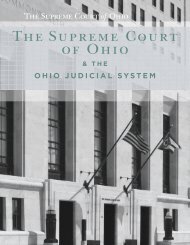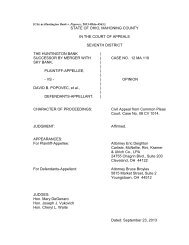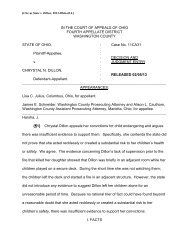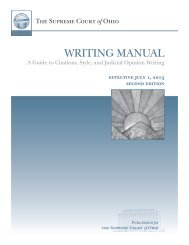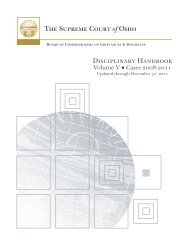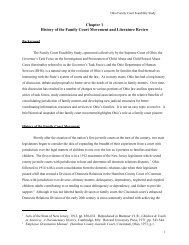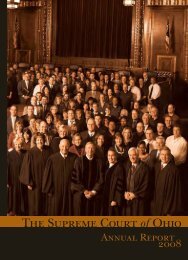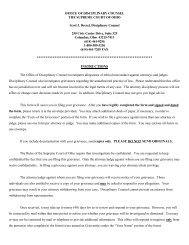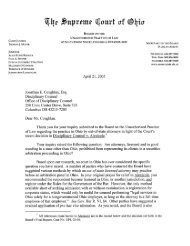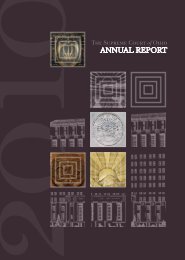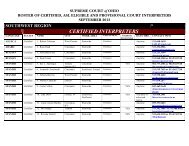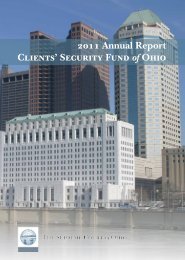The Joint Committee to Study Court Costs and ... - Supreme Court
The Joint Committee to Study Court Costs and ... - Supreme Court
The Joint Committee to Study Court Costs and ... - Supreme Court
Create successful ePaper yourself
Turn your PDF publications into a flip-book with our unique Google optimized e-Paper software.
efunds <strong>to</strong> collect unpaid court costs. Such a program should be further<br />
examined for its feasibility <strong>and</strong> possibility of success.<br />
8. <strong>Court</strong> costs should be returned <strong>to</strong> the funding (collecting)<br />
source.<br />
In <strong>to</strong>day’s system, many courts impose local court costs beyond those<br />
established in the Revised Code. Many of the revenues from these funds are<br />
placed in the county’s or city's general fund. In an optimal situation, the county or<br />
city legislative authority appropriates these funds back <strong>to</strong> the court in the course<br />
of the budget process. In a strong economy this process works well. However,<br />
when the economy is in a downturn, the legislative authority may believe it is<br />
necessary <strong>to</strong> fund other programs with the court cost revenue.<br />
This same scenario occurs at the state level. Funding for indigent defense<br />
is paid for, in part, by a statewide court cost. 4 <strong>The</strong> money collected by the state is<br />
deposited in<strong>to</strong> the General Revenue Fund. In 1997, the court cost was $11 <strong>and</strong><br />
generated $21.6 million per year. In 2008, the court cost is $15 <strong>and</strong> generates<br />
approximately $25.5 million per year. This is an increase of $3.9 million. General<br />
revenue fund appropriations <strong>to</strong> indigent defense over the same period increased<br />
$3.5 million. This means about $400,000 generated by the indigent defense court<br />
cost is being diverted <strong>to</strong> other purposes.<br />
<strong>The</strong> <strong>Joint</strong> <strong>Committee</strong> believes that if the cost is assessed for a specific<br />
purpose, then the funds generated from the imposition of that cost should be<br />
used for that purpose <strong>and</strong> not diverted for other programs or services.<br />
9. <strong>Court</strong> costs should be assessed on each case as defined by the<br />
<strong>Supreme</strong> <strong>Court</strong> of Ohio through the Rules of Superintendence.<br />
<strong>The</strong>re are courts in Ohio assessing court costs on each offense, or count,<br />
in an indictment. This results in multiple court costs being assessed on a party. In<br />
Middleburg Hts. v. Quinones, 2007 WL 2051994 (Ohio App. 8 Dist.), 2007-Ohio<br />
3643, the Eighth District <strong>Court</strong> of Appeals held that court costs should be<br />
assessed for each case <strong>and</strong> not for each offense. That case currently is pending<br />
before the <strong>Supreme</strong> <strong>Court</strong> of Ohio.<br />
<strong>The</strong> <strong>Joint</strong> <strong>Committee</strong> believes courts should assess court costs on a case,<br />
as defined by the Rules of Superintendence for the <strong>Court</strong>s of Ohio. 5 <strong>The</strong><br />
<strong>Supreme</strong> <strong>Court</strong> should consider defining a case so counts are not added simply<br />
<strong>to</strong> generate costs. If multiple counts of an indictment are severed, the defendant<br />
4 R.C. §2949.091<br />
5 Sup. R. 2(A); Sup. R. 37(A)(4)(c)<br />
8



